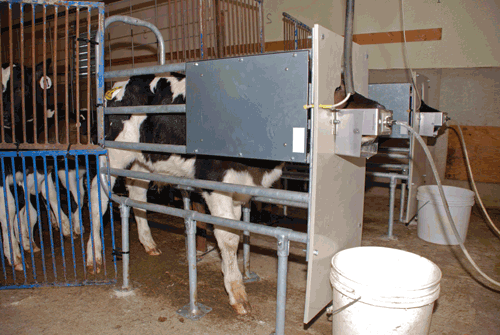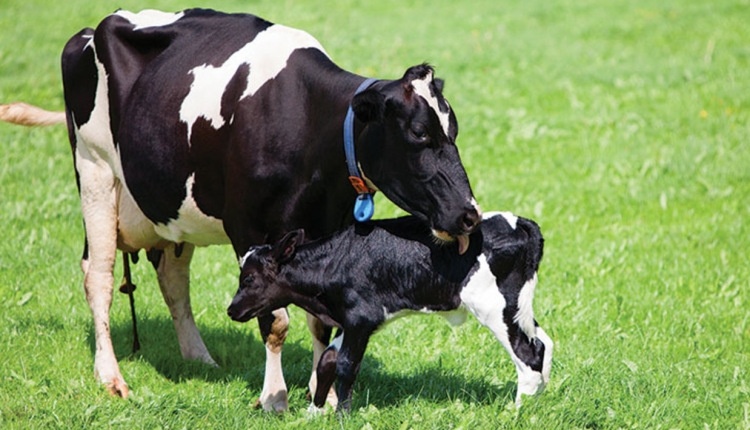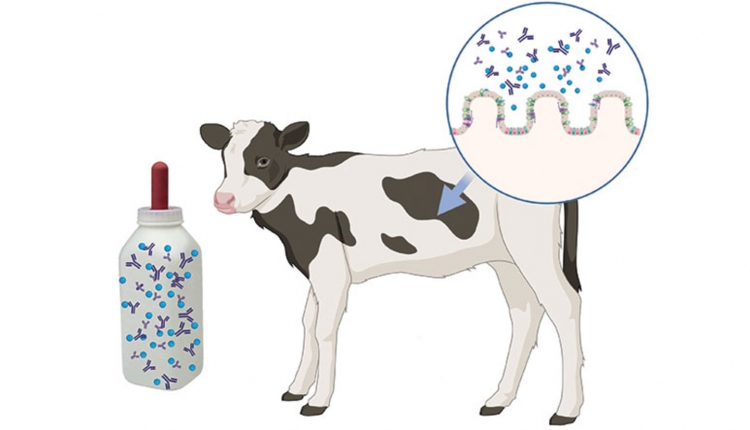Earleywine is director of technical services for Land O'Lakes Animal Milk Products Company, Shoreview, Minn. Johnson and Stephas are at the Land O'Lakes Research Farm, Webster City, Iowa.

Automatic feeders eliminate time spent mixing and feeding milk replacer. That leaves more time to watch calves closely which is important. The group housing works if you start with healthy calves.
Automatic calf feeders are generating considerable interest. These modern machines, which have only recently migrated across the pond from Europe, are equipped to handle 25 to 30 calves per station with a typical arrangement, including two nipples to accommodate around 50 or 60 calves. But using a "robotic" feeder in a calf program means group housing calves. What are the risks associated with that? And what is the level of nutrition that performs best in the feeder?
With these and other questions from dairy producers in mind, as well as curiosity from Land O'Lakes staff, we decided to install a system at the Answer Farm, our research facility at Fort Dodge, Iowa. Our model was purchased directly from Förster-Technik in Germany and designed to feed around 50 calves through two nipples. Both GEA WestfaliaSurge and DeLaval sell versions of the same machine we had installed.
So far, our research team has conducted six full trials and two partial ones involving around 340 calves. All research calves are Holstein sale barn bull calves purchased from various sources in Wisconsin. About 30 percent of them arrive colostrum deprived, with one group having as high as 80 percent failure of passive transfer. All calves were weaned at 6 to 8 weeks of age.
The good news was . . .
As we had hoped, the auto feeder proved to be a great way to feed calves a full potential plane of nutrition. It consisted of a 28 percent protein, 20 percent fat (28:20) milk replacer with soluble fiber technology. Our calves are fed 2.5 pounds of powder mixed at 15 percent solids for a 2-gallon daily feeding of replacer. Each feeding was between 0.5 and 2 quarts of solution, and calves averaged four to eight meals per day.
In our trials, calves raised on the auto feeder grew very well but were similar to those fed the same diet in the standard two feedings per day. This is in line with research done at the University of British Columbia which found excellent growth rates when calves were free to drink at their own pace. Nutrient utilization likely is improved when calves consume milk replacer over more feedings, promoting more efficient gain.
The table shows our recommendations for nutrition levels of calves on the feeder. (Note: This schedule assumes calves have been backgrounded by individual feeding for 10 days.)
To help calves transition into groups, we recommend that the feeder be set to feed calves only two to four times a day for the first two or three days. During the week of weaning, calves again should be limited to only two feedings per day and their level of milk replacer cut in half.
The auto feeder also did a fantastic job of properly mixing and dispensing milk replacer. The machine removed all human error associated with the process and allowed our staff to become calf managers, not feeders.
The success we've had with group housing calves has been the biggest surprise of our research. Over the past few years, our industry has placed great emphasis on eliminating nose-to-nose contact by young calves. However, we've yet to experience an infectious-disease problem with our group-fed calves and have not lost a calf on the feeder.
One key component to that success has been a decision made early on to "background" calves before starting them on the feeder. As our calves were arriving from sale barns and needed some extra attention, our staff found it helpful to feed them individually in pens for 12 days to monitor for signs of scours and disease before a transition to group housing. Over the course of the trials, calves that were backgrounded gained an additional 10 pounds versus those that were not. Dairies that have excellent colostrum management may be able to background for a shorter time.
The calf starter auto feeder, which is a separate piece of equipment, was not effective and was removed during our third farm trial. Calves fed starter through the machine had consistently lower intakes and did not transition well through weaning. We found that installing a feed bunk was far more effective and encouraged intake.
Calves have a herding mentality and were far more likely to eat as a group at a bunk than individually in a stall. This especially was true of shy, timid calves. In Europe, calves often are weaned at 10 to 12 weeks of age which may result in greater success with the grain feeder.
Trials with different levels of nutrition have generated interesting results regarding auto feeder stall occupancy time by calves. While most of our trials have been conducted with a 28:20 full potential feeding program, others were done to look at the impact of nutrition on the results.
What we found was that calves fed the traditional 1.5 pounds of a 20:20 milk replacer actually spent more time at the feeder, especially occupancy time while not drinking. Researchers from Denmark had similar experience with reduced feeding rates. These calves would vocalize and refuse to move from the stall once their feeding was completed because they were still hungry. Traditional nutrition recommendations for calves just aren't enough to satisfy our modern-day calves.
While the addition of an auto feeder to your calf program will eliminate the need for mixing and feeding milk replacer, as one Canadian dairy farmer put it: "I don't spend any less time with my calves." Instead of day-to-day tasks, you'll need to assume more management and observation of calves, especially as scours and other diseases can be more challenging to identify accurately in a group setting. The advantage is convenience and being able to do calf chores on your own schedule.

These are some basic routine procedures we recommend to people using an auto feeder:
For the calves:
• Background calves individually until they have a strong suckling reflex and are disease-free.
• Ensure calves have fresh water, clean bedding, and a draft-free environment.
• Monitor calf performance by evaluating computer readings of eating behavior and by directly observing calves.
• Identify calves that behave abnormally, and evaluate them more closely for signs of disease.
• Look for signs of dehydration such as sunken eyes, check skin tinting, and look for lack of moisture around the nose and eyes.
For the machine:
• Check the milk powder hopper and replenish, if necessary.
• Calibrate powder delivery and any medication delivery at least once a week.
• Monitor the mixer cleaning cycle, and run it at least twice a day.
• Check the powder outlet of the hopper, and look for any caking.
• Check suction hose and nipple several times a week, and monitor flow rate.
• Keep water sensor in mixer free of mineral buildup.
Be sure to work with a calf care expert when designing your system, and make sure the level of nutrition will allow your calves to perform to their potential.
Click here to return to the Calf & Heifer E-Sources
090910_582

Automatic feeders eliminate time spent mixing and feeding milk replacer. That leaves more time to watch calves closely which is important. The group housing works if you start with healthy calves.
Automatic calf feeders are generating considerable interest. These modern machines, which have only recently migrated across the pond from Europe, are equipped to handle 25 to 30 calves per station with a typical arrangement, including two nipples to accommodate around 50 or 60 calves. But using a "robotic" feeder in a calf program means group housing calves. What are the risks associated with that? And what is the level of nutrition that performs best in the feeder?
With these and other questions from dairy producers in mind, as well as curiosity from Land O'Lakes staff, we decided to install a system at the Answer Farm, our research facility at Fort Dodge, Iowa. Our model was purchased directly from Förster-Technik in Germany and designed to feed around 50 calves through two nipples. Both GEA WestfaliaSurge and DeLaval sell versions of the same machine we had installed.
So far, our research team has conducted six full trials and two partial ones involving around 340 calves. All research calves are Holstein sale barn bull calves purchased from various sources in Wisconsin. About 30 percent of them arrive colostrum deprived, with one group having as high as 80 percent failure of passive transfer. All calves were weaned at 6 to 8 weeks of age.
The good news was . . .
As we had hoped, the auto feeder proved to be a great way to feed calves a full potential plane of nutrition. It consisted of a 28 percent protein, 20 percent fat (28:20) milk replacer with soluble fiber technology. Our calves are fed 2.5 pounds of powder mixed at 15 percent solids for a 2-gallon daily feeding of replacer. Each feeding was between 0.5 and 2 quarts of solution, and calves averaged four to eight meals per day.
In our trials, calves raised on the auto feeder grew very well but were similar to those fed the same diet in the standard two feedings per day. This is in line with research done at the University of British Columbia which found excellent growth rates when calves were free to drink at their own pace. Nutrient utilization likely is improved when calves consume milk replacer over more feedings, promoting more efficient gain.
The table shows our recommendations for nutrition levels of calves on the feeder. (Note: This schedule assumes calves have been backgrounded by individual feeding for 10 days.)
To help calves transition into groups, we recommend that the feeder be set to feed calves only two to four times a day for the first two or three days. During the week of weaning, calves again should be limited to only two feedings per day and their level of milk replacer cut in half.
The auto feeder also did a fantastic job of properly mixing and dispensing milk replacer. The machine removed all human error associated with the process and allowed our staff to become calf managers, not feeders.
The success we've had with group housing calves has been the biggest surprise of our research. Over the past few years, our industry has placed great emphasis on eliminating nose-to-nose contact by young calves. However, we've yet to experience an infectious-disease problem with our group-fed calves and have not lost a calf on the feeder.
One key component to that success has been a decision made early on to "background" calves before starting them on the feeder. As our calves were arriving from sale barns and needed some extra attention, our staff found it helpful to feed them individually in pens for 12 days to monitor for signs of scours and disease before a transition to group housing. Over the course of the trials, calves that were backgrounded gained an additional 10 pounds versus those that were not. Dairies that have excellent colostrum management may be able to background for a shorter time.
The calf starter auto feeder, which is a separate piece of equipment, was not effective and was removed during our third farm trial. Calves fed starter through the machine had consistently lower intakes and did not transition well through weaning. We found that installing a feed bunk was far more effective and encouraged intake.
Calves have a herding mentality and were far more likely to eat as a group at a bunk than individually in a stall. This especially was true of shy, timid calves. In Europe, calves often are weaned at 10 to 12 weeks of age which may result in greater success with the grain feeder.
Trials with different levels of nutrition have generated interesting results regarding auto feeder stall occupancy time by calves. While most of our trials have been conducted with a 28:20 full potential feeding program, others were done to look at the impact of nutrition on the results.
What we found was that calves fed the traditional 1.5 pounds of a 20:20 milk replacer actually spent more time at the feeder, especially occupancy time while not drinking. Researchers from Denmark had similar experience with reduced feeding rates. These calves would vocalize and refuse to move from the stall once their feeding was completed because they were still hungry. Traditional nutrition recommendations for calves just aren't enough to satisfy our modern-day calves.
While the addition of an auto feeder to your calf program will eliminate the need for mixing and feeding milk replacer, as one Canadian dairy farmer put it: "I don't spend any less time with my calves." Instead of day-to-day tasks, you'll need to assume more management and observation of calves, especially as scours and other diseases can be more challenging to identify accurately in a group setting. The advantage is convenience and being able to do calf chores on your own schedule.

These are some basic routine procedures we recommend to people using an auto feeder:
For the calves:
• Background calves individually until they have a strong suckling reflex and are disease-free.
• Ensure calves have fresh water, clean bedding, and a draft-free environment.
• Monitor calf performance by evaluating computer readings of eating behavior and by directly observing calves.
• Identify calves that behave abnormally, and evaluate them more closely for signs of disease.
• Look for signs of dehydration such as sunken eyes, check skin tinting, and look for lack of moisture around the nose and eyes.
For the machine:
• Check the milk powder hopper and replenish, if necessary.
• Calibrate powder delivery and any medication delivery at least once a week.
• Monitor the mixer cleaning cycle, and run it at least twice a day.
• Check the powder outlet of the hopper, and look for any caking.
• Check suction hose and nipple several times a week, and monitor flow rate.
• Keep water sensor in mixer free of mineral buildup.
Be sure to work with a calf care expert when designing your system, and make sure the level of nutrition will allow your calves to perform to their potential.
090910_582








